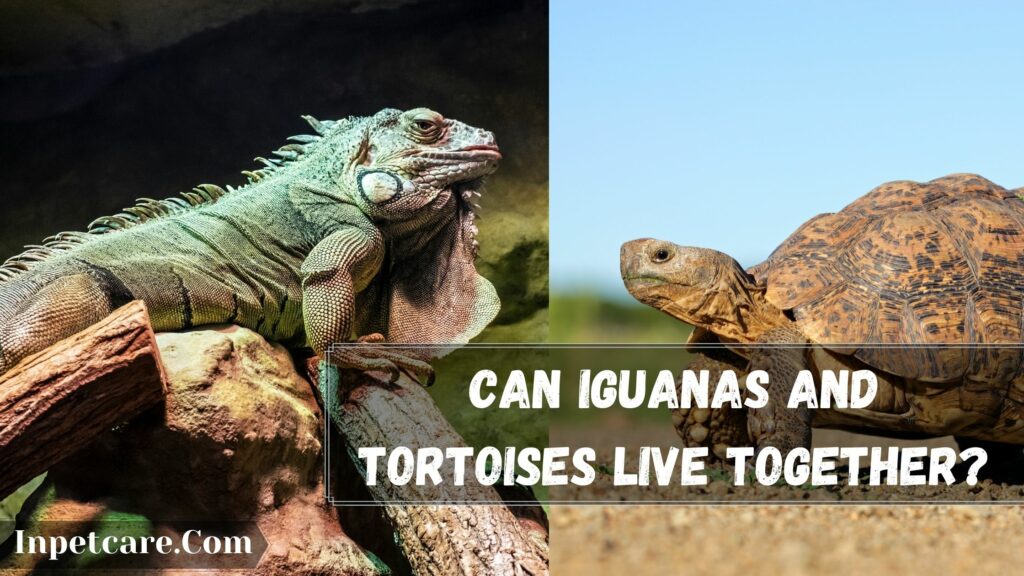If you own an Iguana, it might have crossed your mind to add another reptile, such as a tortoise, to the family too, or vice-versa. Before you do this, many questions need answering. The main one is, do Iguanas and tortoises get along?
In this post, we will answer that question and look at the different views from vets and experts to discover the scenarios when Iguanas and tortoises get along and when it’s best to keep them apart. So do Iguanas and tortoises get along? Iguanas and tortoises can get along in certain circumstances.
Different reptile species shouldn’t be housed together in the same tank, but they can be accommodated in separate tanks and come into contact with constant owner supervision. Let’s talk whether Can Iguanas And Tortoises Live Together.
Can Iguanas And Tortoises Live Together?

Certain Iguana Species and tortoises can live successfully together when set up correctly in same-species tanks. Snakes, however, are best housed singly and generally should not be combined in one tank, even if they are of the same species.
Some owners decide to opt for a different reptile species for their second pet, and a combination of Iguanas and tortoises are common considerations. Before you take steps to bring home a second reptile, it’s essential to know if both the Iguana and tortoise will get along.
You might hear stories that many reptile owners have successfully housed multiple reptile species, including Iguanas and tortoises. Iguanas and tortoises can live in the same family home and get along fine (not housed together, later on). However, specific criteria need to be met and things you need to know before doing this.
The main question that owners want to answer is if Iguanas and tortoises can get along when in direct contact with each other? There’s a good chance they can get along fine, and many owners have both Iguanas and tortoises in the same home, but all reptiles have their personalities, and this will depend on how they react to each other.
Both Iguanas and tortoises have calm temperaments, but they can produce aggressive or submissive behavior if they feel threatened. You, as an owner, can play your part to help the transition of bringing a new reptile home a smooth one. Let’s look at some essential tips to ensure your Iguana and tortoise are comfortable in each other’s company.
Do Iguanas & Tortoises Get along When Housed Together?
The first thing that every potential Iguana and tortoise owner wants to know is, can they get along when housed together in the same tank? Even though this is a logical question, our advice is never to house an Iguana and tortoise in the same tank.
This isn’t just our opinion either; the veterinary experts also advise that different species of reptiles should never be housed in the same tank.
If you were to search up the temperature requirements of both Iguanas and most tortoises, you would find that they are very similar, leading owners to think it’s ok to house them together.
This is far from the truth as many other things to consider when housing two or more of the same species together, let alone different species. Let’s look at the most common concerns of housing Iguanas and tortoises together.
3 Things To Look For When Housing Them Together
Aggressive Behaviour
Before I begin, I want to say that not all Iguanas and tortoises will be aggressive towards each other. However, there is always a risk that we believe isn’t worth taking. Iguanas are solitary reptiles and generally don’t like the company of other Iguanas, let alone other species of reptiles.
If another reptile, such as a tortoise, is added to their enclosure, this can cause many territorial conflicts and aggressive behavior. The last thing you want is for your Iguana or tortoise to be forced to display aggressive behavior because they are trapped in the same living space.
Tortoises are also known to become aggressive when put in uncomfortable positions. Exotic direct says that male tortoises are primarily known to headbang and bite to mark their territory. Although this is usually towards males of the same species, they can be aggressive to protect themselves in many other situations, including other reptiles and predators.
Housing an Iguana and a tortoise in the same tank with no territorial issues have a slight chance of success, but it’s not worth the risk. If they display aggressive behavior, this can result in lost toes and worse. It’s also not suitable for both reptiles’ stress levels. When reptiles such as Iguanas and tortoises encounter aggressive or stressful situations, they should only last a short period.
They would remove themselves from the case in the wild, or the other reptile would withdraw from the position depending on who is more aggressive and dominant. If you house both an Iguana and tortoise in the same tank, then neither of them has the opportunity to back away from the situation.
Feeling Stressed
Both reptiles show aggressive behavior; there’s also a possibility that one of them will become uneasy and even scared by the whole situation of being housed with another reptile. This can easily cause one of the reptiles to become stressed, particularly Iguanas. Iguanas can get stressed and intimidated quickly when put into situations they are unsure about.
This can lead them to hide for prolonged periods and even feel scared to come out and bask when they need to. Heightened stress levels for any reptile aren’t good for long periods, so it’s always better to avoid anything that can trigger them.
There will always be owners who have successfully housed Iguanas and tortoises together with no territorial, aggression, and stress problems, but the risk isn’t worth taking.
Providing Equal Amounts Of Food
Tortoises are herbivores and require a healthy and balanced diet of greens and vegetables in their diet. The experts at Exotic Direct say feeding a tortoise a calcium-rich diet is essential for bone health and shell development.
Even though Iguanas can eat live insects, they still require a high calcium diet provided by selected greens and veggies, just like tortoises do. If you housed an Iguana and tortoise together, it would be tough to ensure that both reptiles received daily nutrients, especially calcium.
This is because the tortoise could eat both bowls of salad or vice-versa. It would be almost impossible to provide equal portions of the greens vital to their health.
3 Tips For Iguanas & Tortoises Getting Along Successfully

For Iguanas and tortoises to get along, there are some things you can do as an owner that will make the process a much smoother one. Let’s look at what you can do to enable both reptiles to get along and accept each other.
Quarantine For One Month
At first, this might sound pretty harsh, but it’s essential to quarantine any new reptile you bring into your home for one month. This ensures that the new serpent doesn’t have any parasites or ticks that can transfer to the reptile already living in your home.
Although this may not be something that will strictly allow them to get along better, it’s still essential. Veterinarians talk about the risk of transferring parasites from reptile to reptile and highly recommend a one-month quarantine. VCA-Hospitals also talk about how iguanas can quickly get mites and ticks, so this is something you should take seriously.
When we say ‘quarantine,’ we mean to isolate the new reptile and make sure it has no contact with your other reptile for one month so you can be sure it is parasite free.
Interesting Further Reading
- How Fast Can Iguanas Run? 6 Amazing Facts
- Iguana Vs Monitor Lizard: 7 Key Differences
- 3 Ways To Tell If Iguana Is Male Or Female
Introduce The Reptiles to Each Other Slowly
Once the one-month period has passed and you are confident that the new reptile doesn’t have parasites, you can slowly start introducing the reptiles to each other. It would help to allow both the Iguana and tortoise lots of space so they don’t feel threatened or intimidated.
You should never place them close together or try and push them towards each other. Just let them check each other out and, after a few minutes, separate them until the next day. Keep slowly introducing them over several days and increasing their time in each other’s company if they seem comfortable.
After a while, they should both accept each other, although this isn’t something that anybody can guarantee. You should always watch over them and never leave them in the same room unattended, even if they seem to be getting along fine.
Make Sure Both Reptiles Are Happy
If, at any point, one of the reptiles doesn’t seem comfortable with the situation, then you will have to use your judgment for what to do next. Keep them separated for a while and try again in a week or so. Persist with the method for a few days to see if they both adjust. It is best to Keep them both separated permanently. Ultimately, you want to keep pets that are both happy and healthy. If the situation long-term stresses either your Iguana or tortoise, it isn’t good for anybody. Hopefully, this won’t be the case, and they will accept each other and get along fine. Now let’s look at housing arrangements and what are the best scenarios.
Can Iguanas And Tortoises Live In The Same Room?
It’s possible to have an Iguana and a tortoise housed in separate tanks but in the same room with no problems. This will depend on the individual temperaments and personalities of your reptiles. Some Iguanas and tortoises may still be unhappy if they can see another reptile in the same room, and this can lead them to feel either aggressive or stressed through fear.
If you want to house your Iguana and tortoise in the same room, we recommend housing them far apart. If you don’t get any problems, all is good with the housing arrangement, and you don’t need to adjust anything. However, if you have problems, you need to make sure you have an alternate room in your home to house one of the reptiles.
You should already have this room prepared before you purchase the second reptile, so if the problems arise, you can move the new pey before the situation becomes too stressful. Sometimes even just making sure both pets can’t see each other is enough to stop any aggressive behavior or stressful situation from developing. Still, you need to have a second room prepared just in case.

94% of pet owners say their animal pal makes them smile more than once a day. In 2007, I realized that I was made for saving Animals. My father is a Vet, and I think every pet deserves one. I started this blog, “InPetCare”, in 2019 with my father to enlighten a wider audience.

